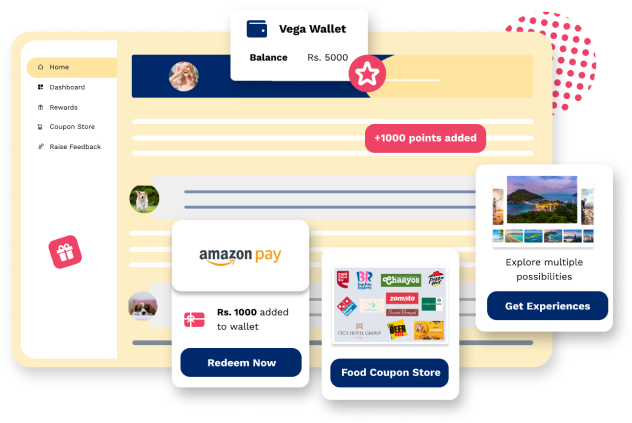Introduction
We are in the age of the 'experience economy,' and experience is the deciding competitive factor in many ways. Employee engagement is as key to the success of an organization as customer experience is. Employees are, after all, ultimately responsible for creating your organization's customer experience. The way they work and their effort depend mainly on the experience journey that an organization designs for them.
A lot of things come into play when we talk about employee engagement. Things such as - how connected they are with their peers and manager,how happy employees feel at work, and how often they feel appreciated and recognized for their contributions are just a few factors when it comes to engagement.
When employees are truly engaged, teams go from being good to being great. Challenges turn into opportunities, outcomes turn into achievements, and people give it their all. Let's explore this more closely.
Importance of Employee Engagement
Beyond its impact on retention, profit margins, employer branding, and other aspects of organizations, employee engagement matters to employees the most. Simply put, prioritizing employee engagement displays to your staff that you care about them as individuals, and are not just individual contributors.
Empathy and compassion are taboo in business, with an unfair stereotype that neither will get you anywhere. But, those are the very cornerstones of successful employee engagement; if you are willing your employees to invest in — or at the very least, care about — your company and what you believe in, you must do the same for them as well.
As per the survey, 92% of employees believe that compassionate leaders are crucial to retention. While retention is a good indicator of engagement levels, engaged employees do not just stick around: 77% of employees would work for hours, and 60% would take a pay cut to work for a compassionate employer.
Nevertheless, organizational decisions are informed by tangible results and data; every aspect of organization should be tied to a positive business impact, and employee engagement is no exception in such scenarios. There are some key drivers to identify why employee engagement is essential.
Key Drivers of Employee Engagement
Employee engagement aims to offer maximum value to both individual employees and the organization throughout the entire lifecycle of employees. It seeks to prevent high-value and high-potential employees from leaving the organization. Many things depend on the communication process between the employees and top management. However, there are many other drivers of employee engagement, which are as follows:
Are You Ready to Supercharge Your Employee Engagement Initiatives?
Explore Vega HRs Comprehensive Suite of Employee Engagement Solutions Designed to Transform Your Workplace to Ensure Success.
Onboarding- True employee engagement begins with seamless onboarding, which happens when a new employee is recruited. However, even before they are hired, they get an idea of the communication culture prevailing in the organization. After being hired, the onboarding process gives them a glimpse of whether they wish to work for the organization or not. One of the best ways to engage employees during onboarding is to provide them with enough time to gain mastery over their job.
Workplace culture- It is one of the most critical drivers of employee engagement. Organizations can build a transparent and positive workplace culture by setting clear expectations, sharing company goals, maintaining proper communication, and providing regular updates. It's all about enhancing openness to make employees feel respected and valued. At the same time, it's also essential for organizations to provide autonomy and ample learning and development opportunities to enhance employee experience.
Technology- One critical factor contributing to employee engagement in modern-day companies is the technology that helps employees boost productivity and manage time. A gamut of activities, unplanned meetings, and tasks can distract employees, often bringing down their productivity and efficiency. However, many tools are available in place that assists employees to keep pace with a dynamic work environment. Such tools assist them to break down their goals into achievable tasks and meet deadlines.
Leadership- Perhaps the most critical driver of employee engagement is the leadership of the organization itself. Employee engagement totally depends on the quality of leadership to a great extent. It is valid in terms of how leaders nurture engaged employees and how their degree of engagement is projected to groups and teams. As such, leaders are required to build trust, provide clarity on organizational purpose, remove bureaucracy, ensure alignment of systems, and unleash valuable talent to create a highly engaged workforce.
Benefits of Employee Engagement
Employee engagement has many benefits, from more satisfied customers to increased revenue.
1. Customer satisfaction
Consumers can witness the difference between one that's just putting in the time and an engaged workforce. As per the research, employee engagement is robustly concerned with increased customer satisfaction. Whether it's a consumer service representative that goes above and beyond to solve a frustrating issue, a sales professional who anticipates the client's every need, or just a vendor's eager attitude every time you call them, engaged employees mean more satisfied customers.
2. Employee performance
Engaged employees perform in a better way— no matter what they put their minds to. According to researchers, companies with engaged employees outperform their equivalents by 202%. When your team is stimulated, not only do they give their all for every task, but they proactively look out for the resources and information they require to succeed. When they do not, they'll do what they need to do and check out whether the result was successful or not.
3. Employee morale
If you are motivated to excel at your job, you are more likely to enjoy it. After all, shelling hours every day doing something you do not believe in is quite demoralizing. However, performing tasks that you find meaningful can lead to great satisfaction both at home and at work. Work hard to keep employees engaged, and higher morale is likely to result.
4. Employee retention
Retaining the top talent is never an easy task, even when the job market is packed. However, boosting employee engagement can assist in many ways. Engaged employees are essentially less likely to job hunt. When you find your work exciting and motivating, the grass on the other side doesn't look quite as green.
5. Employee wellness
Wellness involves everything that leads to a well-balanced, healthy workforce. Practices such as mindfulness, self-awareness, and emotional intelligence are essential to mental health while encouraging fitness and other healthy habits to improve physical well-being. The evacuating effect of disengagement takes a mental toll, so keeping employees committed and motivated is an essential part of supporting emotional health.
Engage your workforce with Vega-HR
Having the right tool makes a big difference when trying to drive engagement. You are required to solicit, understand, and act on employee feedback, and recognition should be easy for everyone at your organization.
Vega-HR's rewards and recognition are the integrated employee experience solution that makes triggering and acting on employee feedback easy with pulse surveys, analytics tools, intuitive reporting, and guidance that empowers managers to respond to results effectively. Enabling all team members to show appreciation from anywhere involves a points-based reward system supported by numerous products and experiences employees love. To know more, book a free session today!
Frequently asked questions
About Vega HR
Vega-HR is a powerful tool in the talent war, offering employee rewards, recognition, and pulse recognition. With an engaging platform, it fosters a world-class work culture, providing P2P recognition, social feedback, on-spot recognition, and monetizable incentive solutions with 3000+ coupons in various categories.
Create a Culture People Want to Stick to
- Send rewards
- Give shoutouts
- Build a community
- Gift experiences
Get a demo
 Written by Ali 06 October 2022 | 4 min read
Written by Ali 06 October 2022 | 4 min read




